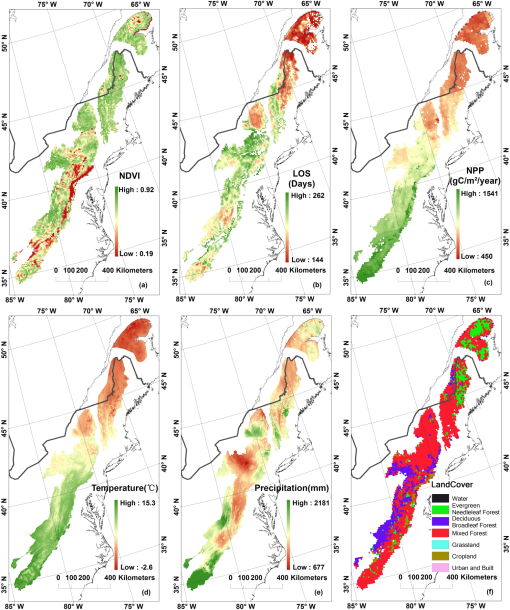|
|
1.IntroductionThe Appalachian Mountains, also known as the Appalachians, are a system of mountains in eastern North America. They run from central Alabama to the New England region of the northeast United States and extend into sections of Quebec, New Brunswick, and Newfoundland in Canada. The mountain range forms a natural barrier between the eastern coastal regions and the interior lowlands of northeastern America. The forests of the Appalachians sustain a variety of ecosystems and native biological diversity. The environmental effects and ecosystem functions and services associated with the Appalachians have long been the focus of scientific research in understanding the mountain range as a unique geographic entity and in comparison with different spatial contexts for providing a regional reference and validation. The Appalachian Trail is an iconic footpath that traverses high-elevation ridges of the Appalachian Mountains. The trail extends over 3500 km across 14 states in the eastern United States from Springer Mountain in northern Georgia to Mount Katahdin in central Maine. The gradients in elevation, latitude, and moisture sustain a rich biological assemblage of temperate zone forest species. The north-south alignment of the Appalachian Trail corridor represents a cross-section mega-transect of the eastern U.S. forests and alpine areas and provides a barometer for early detection of undesirable changes in the natural resources, such as development encroachment, acid precipitation, invasions of exotic species, and climate change impacts.1,2 Climate change studies reveal the effects of global warming on the growing season of terrestrial vegetation at middle and high latitudes.3,4 Over the 20th century, the global average surface temperature increased . Observable warming occurred between 1976 and 2000, and temperatures are projected to increase5,6 by 1.4°C to 5.8°C from 1990 to 2100. Tracking variations in landscape dynamics provides an understanding of the changing environment, the impacts and threats caused by changes, and the likely trends in the future for natural resources and associated ecosystems.7 Time series remote sensing data provide necessary observations in revealing patterns of landscape dynamics either by abrupt change or gradual variations. The normalized difference vegetation index (NDVI) has been effectively used for monitoring vegetation dynamics. Consistent and long time-series NDVI data are important for analysis of vegetation responses to global change in terrestrial ecosystems.8 The Global Inventory Monitoring and Modeling Studies (GIMMS) NDVI dataset derived from Advanced Very High Resolution Radiometer (AVHRR) has been broadly used for studying vegetation activity on regional and global scales. Phenology studies have long been reported in different domains, such as climate change.9 biodiversity,10 wildlife ecology,11 snow dynamics,12 fire effects,13 and crops.14 Land surface phenology (LSP) is one of the measures of landscape dynamics. It reflects the response of vegetated surfaces to seasonal and annual changes in the climatic and hydrologic cycle. LSP is strongly linked to climatic factors.15 It has been broadly studied in the context of ecosystem responses to climate change16 and for monitoring and understanding global change in vegetation lifecycle events. Because of spatial resolution of remote sensing data, LSP is described as an indicator of mixtures of land covers and is distinct from traditional notion of species-centric phenology, such as seasonal flowering or budburst.17,18 Because LSP is based on remote sensing observations at regional and global scales, it serves as a key biological indicator for detecting the response of terrestrial ecosystems to climatic variation. LSP metrics are primarily based on time series images of vegetation indices from optical sensors such as AVHRR, spot-vegetation (VGT), and moderate resolution imaging spectroradiometer (MODIS). These metrics typically retrieve the time of the onset of greenness as the start of the season (SOS), onset of senescence or time of end of greenness as the end of the season (EOS), timing of the maximum of the growing season by peak vegetation indices, and the length of growing season (LOS) or duration of greenness. An increasing number of studies have reported the shifts in timing and length of the growing season based on phenology, satellite data, and climatological studies.6 Net primary production (NPP) plays an important role in the Earth surface system’s health19 and the terrestrial carbon cycle.20,21 NPP and its response to climate change have been the focus of global change research.22 Studies have been conducted based on historical datasets.23–32 Recent climatic changes have enhanced plant growth in northern middle and high latitudes.31 Various NPP models have been developed to analyze NPP response to climate change.32–42 Regional scale carbon cycle processes and climate patterns provide indications of potential responses and feedback to climate change.43 Other studies showed that temperatures across the northeastern United States have been increasing steadily since the 1970s. A wide range of indicators in the Northeast have already been observed to be responsive to the changes, which in turn have the potential to impact urban and rural life, agriculture, industry, tourism, and natural ecosystems.44 The U.S. Global Change Research Program reported that the annual average temperature in the Northeast has increased by 1.1°C, with winter temperatures rising twice that much, since 1970. At the same time, warming has resulted in many other climate-related changes, including more frequent days with temperatures above 32.2°C, longer growing seasons, increased heavy precipitation, more winter precipitation falling as rain instead of snow, reduced snowpack, earlier breakup of winter ice on lakes and rivers, and earlier spring snowmelt resulting in earlier peak river flows and rising sea surface temperatures and sea levels.45 Projections along the Appalachian Trail corridor area showed a steady temperature increase ranging from 2°C to 6°C by the end of the 21st century. Precipitation, however, did not show any significant trend or decadal variation.46 Therefore, the objective of this study is to investigate the patterns and trends of NDVI, LSP, and NPP of the Appalachian Mountains regions and make comparisons of those variables with different scales of spatial contexts using time series GIMMS and Global Production Efficiency Model (GloPEM) datasets.37,47 2.Materials and Methods2.1.Study AreasThe selected Appalachian Mountains regions consist of four provinces of ecoregions in the United States and Canada covering a latitudinal range between and and in area (Fig. 1). The provinces of ecoregions include the Adirondack-New England Mixed Forest-Coniferous Forest-Alpine Meadow Province, the Eastern Broadleaf Forest Province, and the Central Appalachian Broadleaf Forest-Coniferous Forest-Meadow Province in the United States48 and a section of the Eastern Canadian Forests. Fig. 1The study area consists of four provinces of ecoregions along the Appalachian Mountains in the eastern United States and southeastern Canada. The selected Appalachian Mountains ecoregion provinces include (A) Eastern Canadian Forests, (B) Adirondack-New England Mixed Forest-Coniferous Forest-Alpine Meadow Province, (C) Eastern Broadleaf Forest Province, and (D) Central Appalachian Broadleaf Forest-Coniferous Forest-Meadow Province. North America and an Appalachian Trail corridor area are selected for the comparative studies. 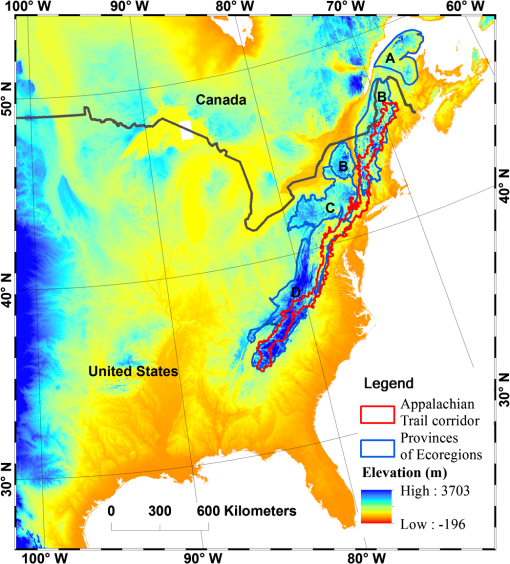 The Adirondack-New England Mixed Forest-Coniferous Forest-Alpine Meadow Province has a modified continental climatic regime with long, cold winters and warm summers. Annual precipitation is evenly distributed. The landscape is mountainous and was previously glaciated. Forest vegetation is a transition between boreal on the north and broadleaf deciduous to the south. The Eastern Broadleaf Forest Province has a continental-type climate of cold winters and warm summers. Annual precipitation is greater during the summer. Topography is variable, ranging from plains to low hills of low relief along the Atlantic coast. Interior areas are high hills to semi-mountainous, parts of which were glaciated. Vegetation is characterized by tall, cold-deciduous broadleaf forests. The Central Appalachian Broadleaf Forest-Coniferous Forest-Meadow Province is a moderately dissected plateau of irregular plains and open hills. Geologic formations are mostly marine deposits of limestones, shales, and sandstone. The existing land cover type is mainly agricultural and urban. Small areas of natural cover types remain, consisting of forests of oak-hickory, maple-beech-birch, and oak-gum-cypress cover types. The Eastern Canadian Forests are characterized by forested land in eastern Quebec, much of Newfoundland, the highlands of New Brunswick, and Cape Breton Island, Nova Scotia. The climate ranges from high and mid-boreal and perhumid mid-boreal to Oceanic, Atlantic, and maritime mid-boreal. Summers are generally cool, with average temperatures ranging from 8.5°C in the north to 14.5°C in the south. Winter temperatures vary according to the proximity to the ocean and continental landmass. In order to reveal the differences and similarities of NDVI, SOS, and NPP in the Appalachian Mountains regions, we compared the variables in different spatial scales with North America and the Appalachian Trail corridor area (Fig. 1), and in different latitudinal ranges from 30°N to 40°N and 40°N to 50°N in North America. 2.2.DatasetsGIMMS49 data derived from AVHRR have been used extensively for global-scale vegetation monitoring and detection of trends in vegetation conditions.50 GIMMS data provide global time series NDVI measurements at a spatial resolution of . The data are composited over a period of approximately 15 days with the maximum value compositing (MVC) technique51 to reduce cloud cover and to maintain temporal frequency. The data have been corrected for calibration, view geometry, volcanic aerosols, and other effects not related to vegetation change.49,52–55 GIMMS data have been used broadly in LSP studies.15,56–63 The GIMMS data were fitted yearly with a Gaussian function to generate smoothed data for each of the 25 years from 1982 to 2006. We used monthly composites of GIMMS data to calculate the LSP metrics. The NPP dataset estimated by AVHRR GloPEM was designed to run with both biological and environmental variables derived.37,47 The GloPEM dataset is available from 1981 to 2000 in 10-day periods or a summed annual level. The dataset is derived from AVHRR images at an 8-km resolution from the AVHRR Pathfinder Project. 2.3.Land Surface Phenology MetricsThe methods to obtain LSP metrics include thresholds, derivatives, smoothing functions, and fitted models.64 The TIMESAT software program65,66 is among those widely used12,13,67–70 In order to reduce dropouts or gaps from long time-series data, TIMESAT uses Savitzky-Golay filtering, asymmetrical Gaussian, or double logistic functions for fitting NDVI data.71 The local Savitzky-Golay function can capture subtle and rapid changes in the time series, but it is also sensitive to noise. The asymmetrical Gaussian and double logistic functions are less sensitive to the noise and can derive a better description of the beginnings and endings of the seasons.65,72 In this study, we adopted the asymmetrical Gaussian approach: where determines the position of the maximum or minimum with respect to the independent time variable , and determine the width and flatness (kurtosis) of the right half function, and and determine the width and flatness of the left half function.2,71In order to make comparisons of LSP in different scales, we employed the GIMMS and the phenology data from the USDA Forest Service that possess 231-m spatial resolution and cover the time period from 2003 to 2006. We then determined the parameter. The SOS is defined as the time for which the left edge has increased to 20% (seasonal amplitude from minimum NDVI to maximum NDVI) measured from the left minimum NDVI. The EOS is defined as the time for which the right edge has decreased to 20% (seasonal amplitude from minimum NDVI to maximum NDVI) measured from the right minimum NDVI. The LOS is the time period measured in days from the SOS to the EOS. We built the smooth time series of NDVI from TIMESAT. We derived the LSP metrics based on and adopted the adaptation strength of 2.0, no spike filtering, and amplitude. We calculated the SOS and EOS for each year and obtained LOS as the difference between SOS and EOS in each grid cell. In this paper, we analyzed the spatial and temporal variation of LOS in the study areas. We used the nonparametric Mann-Kendall test for testing the presence of the monotonic increasing or decreasing trends and the Sen’s method for estimating the slope of linear trends of annual peak values of NDVI, LOS, and NPP. 3.Results3.1.Spatial Pattern Of NDVI, LSP, and NPPFigure 2 illustrates spatial patterns of the mean value of peak NDVI, LSP, NPP, Temperature, Precipitation, and Land Cover. The peak NDVI, LSP, and NPP represent the maximum value of the year and were obtained using the MVC method. The mean peak NDVI, LSP, and NPP were obtained similarly. Land cover types were considered in obtaining the spatial variation of NDVI, as shown in Fig. 2(a) and 2(f). For example, forests are mainly distributed in humid climatic zones of the Appalachian Mountains73 and therefore possess high NDVI values. At pixel scale, the data illustrate spatial dynamics of LOS of the Appalachian Mountains between 1982 and 2006. The spatial variation indicates that the average LOS varied from 144 to 262 days, and extended LOS was observed in low-latitude areas, as shown in Fig. 2(b). The patterns indicate that LOS increased from northeast to southwest in these areas. Spatial pattern reveals that LOS was more responsive to the variation of temperature [Fig. 2(d)] than to precipitation [Fig. 2(e)]. Annual mean NPP ranged from 450 to [Fig. 2(c)] in the Appalachian Mountains over the 20 years from 1991 to 2000. NPP values reflected the latitudinal effects from southwest to northeast at 34°N to 40°N, 40°N to 45°N, and 45°N to 50°N. Areas with low NPP were found in the high-latitude regions, consistent with the changes in temperature [Fig. 2(d)]. The pattern of temperature variation showed a decreasing trend from southwest to northeast. The mean temperature showed high values from 34°N to 40°N, medium values from 40°N to 45° N, and low values from 45°N to 50°N. The precipitation was highest with in the low-latitude regions, as shown in Fig. 2(e). In the southwestern region, the NPP, temperature, and precipitation measures were higher than those in other regions. A combination of higher temperature and precipitation contributes to high NPP in the southwestern region of the Appalachian Mountains. 3.2.Trends Of NDVI, LSP, and NPPThe trend of NDVI in the Appalachian Mountains regions varied from to 0.0056 units. The declining trends of peak NDVI occurred in the Appalachian Mountains, particularly in the central regions [Fig. 3(a)]. Only the section area within the Eastern Canadian Forests showed increasing trends of peak NDVI. Fig. 3Trends in peak NDVI, LOS, and NPP within the selected Appalachian Mountains regions from 1982 to 2006. 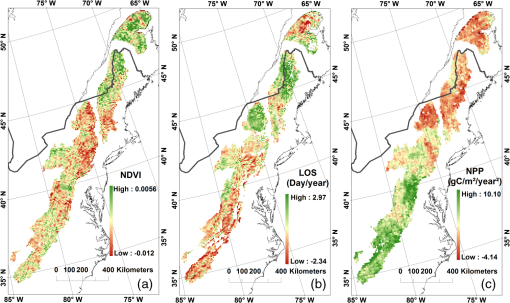 Spatial variations in LOS trends indicate that LOS varied between days (decreasing) to 2.97 days (increasing) per year from 1982 to 2006 over the Appalachian Mountains regions [Fig. 3(b)]. The decreasing trends () were mainly found in the Central Appalachian Broadleaf Forest-Coniferous Forest-Meadow Province and the Eastern Canadian Forests. Positive LOS trends mainly occurred in the Adirondack-New England Mixed Forest-Coniferous Forest-Alpine Meadow Province, as shown in Fig. 3(b). We calculated the trends in NPP at the pixel level (8 km) from 1981 to 2000 using linear least squares. These calculations are shown in Fig. 3(c). Positive and negative NPP trends were found across the Appalachian Mountains regions. Observable increases occurred in the Central Appalachian Broadleaf Forest-Coniferous Forest-Meadow Province and the Northeastern Mixed Forest Province. A decrease in NPP occurred in the northeast, and an increased trend was observed in the southwest of the Appalachian Mountains. 3.3.Comparison of Appalachian Mountains with Different Spatial ContextsThe NDVI data were calculated for vegetated area only. For Figs. 4Fig. 5–6, the straight lines were generated using the method of linear least squares. Significant decrease in annual peak NDVI was observed in the Appalachian Mountains, as well as the Appalachian Trail corridor area (Fig. 4). The average slope in the Appalachian Mountains was a (, ) NDVI unit decrease per year during the 25 years from 1982 to 2006. For the Appalachian Trail corridor area, the average slope was a (, ) NDVI unit decrease per year over the 25 years. However, there was no observable trend in North America or in the selected latitudinal ranges from 30°N to 40°N and from 40°N to 50°N (Fig. 4 and Table 1). Fig. 4The interannual variability of NDVI for the Appalachian Mountains, North America, the 30°N–40°N range in North America, the 40°–50°N range in North America, and the Appalachian Trail corridor area between 1982 and 2006. 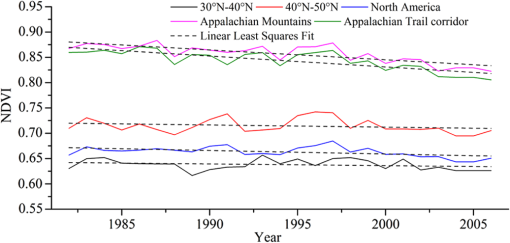 Fig. 5The variation of LOS for the Appalachian Mountains, North America, the 30°N–40°N range in North America, the 40°N–50°N range in North America, and the Appalachian Trail corridor area. 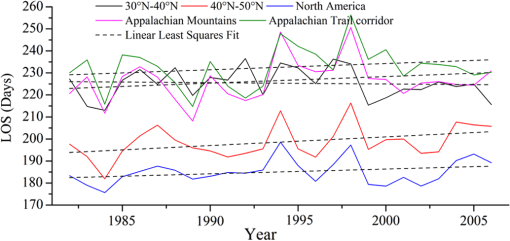 Fig. 6The variation in NPP for the Appalachian Mountains, North America, the 30°N–40°N range in North America, the 40°N–50°N range in North America, and the Appalachian Trail corridor area. 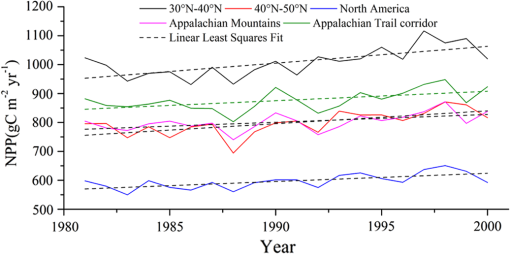 Table 1.The parameters of NDVI, LOS, and NPP
The prolonged LOS was over the entire Appalachian Mountains, in latitudinal zone from 40°N to 50°N, in North America, and in the Appalachian Trail corridor area. However, the LOS trend was shortened by in latitudes from 30°N to 40°N. Although there was no indication of a significant trend in LOS in any region during the study time periods, abnormal values in some years (e.g., 1998 and 1999) were observable against the calculated mean values and are shown in Fig. 5. We calculated the annual mean NPP values for the Appalachian Mountains, North America, and the Appalachian Trail corridor area (Fig. 6 and Table 1). The average NPP values were 1,008, 797, 597, 802, and , in the 30°N–40°N range, the 40–50°N range, North America, the Appalachian Mountains, and the Appalachian Trail corridor area, respectively. The increasing trend in NPP was observed for all the regions during the 20-year period (Fig. 6). The NPP increased (, ) from 1982 to 2006 in Appalachian Mountains. The trends in NPP showed an increase of (, ) in the 30°N–40°N range, (, ) in the 40°N–50°N range, (, ) in North America, and (, ) in the Appalachian Trail corridor. 4.Conclusions and DiscussionThis study revealed the spatial and temporal variations and trends in landscape dynamics, LSP, and NPP in the study area. The comparisons examined the Appalachian Mountains as a unique geographic entity and their topographic and elevation effects in the spatial context. Our conclusions are as follows. The peak NDVI values decreased significantly in the Appalachian Mountains and the Appalachian Trail corridor area (Fig. 4). Both trends possessed higher negative slopes than those in the 30°N–40°N and 40°N–50°N latitudinal zones and North America. The mean peak NDVI values were 0.86 in the Appalachian Mountains and 0.84 in the Appalachian Trail corridor, higher than those of North America. Other studies have suggested that the average annual peak NDVI presented a declining trend over many protected areas in North America.50 Given that neither temperature nor precipitation showed a correlation with NDVI, this may imply that the observed decrease in NDVI was mainly driven by the combination of urban expansion and outbreaks of hemlock wooly adelgids (Adelges tsugae)74–76 and other insect pests. Consistent with the patterns observed in the AVHRR GIMMS data along the Appalachian Trail corridor, analyses using other types of remote sensing data have shown a decrease in forest cover in the eastern U.S., mainly due to the growth of urban areas since the 1970s.7,77–79 There are different results from different methods for calculation of LSP parameters.64 For example, the results from four methods were very much different. The SOS calculated by the moving average method was the lowest, and the EOS value was the highest, but the derivative method delivered the highest SOS value and the lowest EOS value. A reported LSP study suggested that the EOS in North America was delayed by 8.1 days per decade from 1982 to 1999 and by 1.3 days per decade from 2000 to 2008.80 Another study reported that SOS advanced by approximately 8 days, EOS was delayed by 4 days, and LOS increased by 12 days in North America from 1982 to 1999.81 The results of this study suggested that LOS in the Appalachian Mountains advanced 7.5 days from 1982 to 2006. The longest annual mean LOS value (233 days) was observed in the Appalachian Trail corridor area, and the second longest LOS value (227 days) was observed in the Appalachian Mountains regions. The mean LOS in the latitudinal range between 40°N and 50°N increased by (, ) from 1982 to 2006; that increase was higher than those in other regions. The overall trend along the Appalachian Mountains, despite local variations, agreed with broader patterns obtained for the Northern Hemisphere and North America. The local variations were caused by topographic and elevation effects, as well as associated land cover types and ecosystems. To further understand the effect of elevation, we divided the LOS into 20 categories from to 2,025 m. We found that the LOS was shortened by 1.2 days (, ) for every 100-m increase in elevation. The prolonged LOS was mainly attributed to delayed EOS. This study concluded that the variations and trends of LSP metrics in the Appalachian Mountains were comparable to those obtained for the Appalachian Trail corridor area.82 The LOS anomalies in 1987, 1994, and 1998 followed the pattern of warm and cold episodes based on a threshold of for the Oceanic Niño Index (ONI). The reversed LOS patterns correspond to El Niño in 1997 to 1998 and La Niña in 1999 to 2000 events.83 This indicates that LOS is sensitive to climate variations. NPP modeling studies have documented that terrestrial photosynthetic activity has increased over the past two to three decades in the middle and high latitudes in the Northern Hemisphere.28–30,32,84 The mean annual NPP in North America (north of 22°N) was reported as , increasing by (significant at the 99% level) from 1982 to 1998.28 The results from this study illustrated significant increasing trends of NPP from 1981 to 2000 in all the study regions. The NPP in the Appalachian Mountains increased by (, ), a smaller rate than that for North America (, , ). The largest annual mean NPP value () and the largest trend increase (, , ) were observed in the latitudinal range between 30°N and 40°N. The mean NPP in the Appalachian Trail corridor area increased by (, ), which was larger than that for North America and smaller than that for the Appalachian Mountains regions. While prolonged LOS and increasing trends of annual NPP were observed in the Appalachian Mountains and the Appalachian Trail corridor, peak NDVI showed a decreasing trend. There are many factors that could affect the change of NDVI, LOS, and NPP in different spatial contexts of the study areas. The similar pattern of variations and trends between the Appalachian Trail corridor area and the Appalachian Mountains regions suggested that the Appalachian Trail corridor area can serve as a mega-transect to reflect such variations and trends of the Appalachian Mountains regions. AcknowledgmentsThis study was funded by NASA Science Mission Directorate (ROSES-2008) Decision Support through Earth Science Research Results under the project “A Decision Support System for Monitoring, Reporting and Forecasting Ecological Conditions of the Appalachian National Scenic Trail” (Grant NNX09AV82G). In particular, the authors thank the contributions of those who are on the project team to develop the decision support system: Peter August, Roland Duhaime, Christopher Damon, John Clark, Fu Luo, Charles LaBash, and Peter Paton from the University of Rhode Island; Forrest Melton, Hirofumi Hashimoto, Samuel Hiatt, and Ramakrishna Nemani from the NASA Ames Research Center; Fred Dieffenbach, Matt Robison, Casey Reese, and Brian Mitchell from the National Park Service; Ken Stolte from the USDA Forest Service; Glenn Holcomb and Marcia McNiff from the USGS; and Paul Mitchell from the Appalachian Trail Conservancy. Dr. William Hargrove of the Eastern Forest Environmental Threat Assessment Center, USDA Forest Service, provided the 231-m spatial resolution phenology data. The authors wish to express their sincere appreciation for the critiques and suggestions from anonymous reviewers that helped improve the quality of the manuscript. ReferencesThe Appalachian Trail MEGA-Transect, Appalachian Trail Conservancy, Harpers Ferry, WV
(2008). Google Scholar
J. Zhaoet al.,
“The variation of land surface phenology from 1982 to 2006 along the Appalachian Trail,”
IEEE Trans. Geosci. Rem. Sens., 51
(4),
(2013). http://dx.doi.org/10.1109/TGRS.2012.2217149 IGRSD2 0196-2892 Google Scholar
R. B. Myneniet al.,
“Increased plant growth in the northern high latitudes from 1981 to 1991,”
Nature, 386
(6626), 698
–702
(1997). http://dx.doi.org/10.1038/386698a0 NATUAS 0028-0836 Google Scholar
X. Zhanget al.,
“The footprint of urban climates on vegetation phenology,”
Geophys. Res. Lett., 31
(12), L12209
(2004). http://dx.doi.org/10.1029/2004GL020137 GPRLAJ 0094-8276 Google Scholar
Climate Change 2001: The Scientific Basis: Contribution of Working Group I to the Third Assessment Report of the Intergovernmental Panel on Climate Change, 2001). Google Scholar
H. W. Linderholm,
“Growing season changes in the last century,”
Agric. Forest Meteorol., 137
(1–2), 1
–14
(2006). http://dx.doi.org/10.1016/j.agrformet.2006.03.006 0168-1923 Google Scholar
Y. Wanget al.,
“Remote sensing of land-cover change and landscape context of the National Parks: a case study of the Northeast Temperate Network,”
Rem. Sens. Environ., 113
(7), 1453
–1461
(2009). http://dx.doi.org/10.1016/j.rse.2008.09.017 RSEEA7 0034-4257 Google Scholar
M. Brownet al.,
“Neural networks as a tool for constructing continuous NDVI time series from AVHRR and MODIS,”
Int. J. Rem. Sens., 29
(24), 7141
–7158
(2008). http://dx.doi.org/10.1080/01431160802238435 IJSEDK 0143-1161 Google Scholar
F.-W. Badecket al.,
“Responses of spring phenology to climate change,”
New Phytol., 162
(2), 295
–309
(2004). http://dx.doi.org/10.1111/nph.2004.162.issue-2 NEPHAV 0028-646X Google Scholar
A. H. HurlbertJ. P. Haskell,
“The effect of energy and seasonality on avian species richness and community composition,”
Am. Natural., 161
(1), 83
–97
(2003). http://dx.doi.org/10.1086/an.2003.161.issue-1 AMNTA4 0003-0147 Google Scholar
M. HebblewhiteE. MerrillG. McDermid,
“A multi-scale test of the forage maturation hypothesis in a partially migratory ungulate population,”
Ecol. Monogr., 78
(2), 141
–166
(2008). http://dx.doi.org/10.1890/06-1708.1 ECMOAQ 0012-9615 Google Scholar
A. M. Jönssonet al.,
“Annual changes in MODIS vegetation indices of Swedish coniferous forests in relation to snow dynamics and tree phenology,”
Rem. Sens. Environ., 114
(11), 2719
–2730
(2010). http://dx.doi.org/10.1016/j.rse.2010.06.005 RSEEA7 0034-4257 Google Scholar
W. J. D. Van Leeuwen,
“Monitoring the effects of forest restoration treatments on post-fire vegetation recovery with MODIS multitemporal data,”
Sensors, 8
(3), 2017
–2042
(2008). http://dx.doi.org/10.3390/s8032017 SNSRES 0746-9462 Google Scholar
T. Sakamotoet al.,
“A crop phenology detection method using time-series MODIS data,”
Rem. Sens. Environ., 96
(3–4), 366
–374
(2005). http://dx.doi.org/10.1016/j.rse.2005.03.008 RSEEA7 0034-4257 Google Scholar
B. W. Heumannet al.,
“AVHRR derived phenological change in the Sahel and Soudan, Africa, 1982–2005,”
Rem. Sens. Environ., 108
(4), 385
–392
(2007). http://dx.doi.org/10.1016/j.rse.2006.11.025 RSEEA7 0034-4257 Google Scholar
E. E. Clelandet al.,
“Shifting plant phenology in response to global change,”
Trends Ecol. Evol., 22
(7), 357
–365
(2007). http://dx.doi.org/10.1016/j.tree.2007.04.003 TREEEQ 0169-5347 Google Scholar
K. M. de BeursG. M. Henebry,
“Land surface phenology, climatic variation, and institutional change: Analyzing agricultural land cover change in Kazakhstan,”
Remote Sensing of Environment, 89
(4), 497
–509
(2004). http://dx.doi.org/10.1016/j.rse.2003.11.006 RSEEA7 0034-4257 Google Scholar
M. Friedlet al.,
“Land surface phenology,”
(2006). Google Scholar
S. W. RunningP. E. ThorntonR. R. NemaniJ. M. Glassy,
“Global terrestrial gross and net primary productivity from the Earth Observing System,”
Methods in Ecosystem Science, 44
–57 Springer-Verlag, New York
(2000). Google Scholar
C. D. KeelingJ. F. S. ChinT. P. Whorf,
“Increased activity of northern vegetation inferred from atmospheric CO2 measurements,”
Nature, 382
(6587), 146
–149
(1996). http://dx.doi.org/10.1038/382146a0 NATUAS 0028-0836 Google Scholar
C. B. Fieldet al.,
“Primary production of the biosphere: integrating terrestrial and oceanic components,”
Science, 281
(5374), 237
–240
(1998). http://dx.doi.org/10.1126/science.281.5374.237 SCIEAS 0036-8075 Google Scholar
W. Crameret al.,
“Comparing global models of terrestrial net primary productivity (NPP): overview and key results,”
Global Change Biology, 5
(S1), 1
–15
(1999). http://dx.doi.org/10.1046/j.1365-2486.1999.00009.x 1354-1013 Google Scholar
J. M. Melilloet al.,
“Global climate change and terrestrial net primary production,”
Nature, 363
(6426), 234
–240
(1993). http://dx.doi.org/10.1038/363234a0 NATUAS 0028-0836 Google Scholar
C. M. Malmströmet al.,
“Interannual variation in global-scale net primary production: Testing model estimates,”
Global Biogeochem. Cycles, 11
(3), 367
–392 http://dx.doi.org/10.1029/97GB01419 GBCYEP 0886-6236 Google Scholar
C. PengM. J. Apps,
“Modelling the response of net primary productivity (NPP) of boreal forest ecosystems to changes in climate and fire disturbance regimes,”
Ecol. Modell., 122
(3), 175
–193
(1999). http://dx.doi.org/10.1016/S0304-3800(99)00137-4 ECMODT 0304-3800 Google Scholar
D. Schimelet al.,
“Contribution of Increasing and Climate to Carbon Storage by Ecosystems in the United States,”
Science, 287
(5460), 2004
–2006
(2000). http://dx.doi.org/10.1126/science.287.5460.2004 SCIEAS 0036-8075 Google Scholar
W. Luchtet al.,
“Climatic control of the high-latitude vegetation greening trend and Pinatubo effect,”
Science, 296
(5573), 1687
–1689
(2002). http://dx.doi.org/10.1126/science.1071828 SCIEAS 0036-8075 Google Scholar
J. A. Hickeet al.,
“Satellite-derived increases in net primary productivity across North America, 1982–1998,”
Geophys. Res. Lett., 29 4
(2002). http://dx.doi.org/10.1029/2001GL013578 GPRLAJ 0094-8276 Google Scholar
M. Caoet al.,
“Response of terrestrial carbon uptake to climate interannual variability in China,”
Global Change Biol., 9
(4), 536
–546
(2003). http://dx.doi.org/10.1046/j.1365-2486.2003.00617.x 1354-1013 Google Scholar
J. Fanget al.,
“Increasing net primary production in China from 1982 to 1999,”
Front. Ecol. Environ., 1
(6), 293
–297
(2003). http://dx.doi.org/10.1890/1540-9295(2003)001[0294:INPPIC]2.0.CO;2 1540-9295 Google Scholar
R. R. Nemaniet al.,
“Climate-driven increases in global terrestrial net primary production from 1982 to 1999,”
Science, 300
(5625), 1560
–1563
(2003). http://dx.doi.org/10.1126/science.1082750 SCIEAS 0036-8075 Google Scholar
S. PiaoJ. FangJ. He,
“Variations in Vegetation Net Primary Production in the Qinghai-Xizang Plateau, China, from 1982 to 1999,”
Climat. Change, 74
(1), 253
–267
(2006). http://dx.doi.org/10.1007/s10584-005-6339-8 CLCHDX 0165-0009 Google Scholar
S. J. GoetzS. D. Prince,
“Remote sensing of net primary production in boreal forest stands,”
Agric. For. Meteorol., 78
(3–4), 149
–179
(1996). http://dx.doi.org/10.1016/0168-1923(95)02268-6 0168-1923 Google Scholar
S. L. PiaoJ. Y. FangQ.-H. Guo,
“Application of CASE model to the estimation of Chinese terrestrial net primary productivity,”
Acta Phytoecol. Sin., 25
(5), 603
–608
(2001). Google Scholar
C. S. Potteret al.,
“Terrestrial ecosystem production: a process model based on global satellite and surface data,”
Global Biogeochem. Cycles, 7
(4), 811
–841
(1993). http://dx.doi.org/10.1029/93GB02725 GBCYEP 0886-6236 Google Scholar
A. K. Prasadet al.,
“Crop yield estimation model for Iowa using remote sensing and surface parameters,”
Int. J. Appl. Earth Observ. Geoinform., 8
(1), 26
–33
(2006). http://dx.doi.org/10.1016/j.jag.2005.06.002 Google Scholar
S. D. PrinceS. N. Goward,
“Global primary production: a remote sensing approach,”
J. Biogeogr., 22
(4/5), 815
–835
(1995). http://dx.doi.org/10.2307/2845983 JBIODN 1365-2699 Google Scholar
J. SeaquistL. OlssonJ. Ardö,
“A remote sensing-based primary production model for grassland biomes,”
Ecol. Modell., 169
(1), 131
–155
(2003). http://dx.doi.org/10.1016/S0304-3800(03)00267-9 ECMODT 0304-3800 Google Scholar
S. Sitchet al.,
“Evaluation of ecosystem dynamics, plant geography and terrestrial carbon cycling in the LPJ dynamic global vegetation model,”
Global Change Biol., 9
(2), 161
–185
(2003). http://dx.doi.org/10.1046/j.1365-2486.2003.00569.x 1354-1013 Google Scholar
C. TottrupM. S. Rasmussen,
“Mapping long-term changes in savannah crop productivity in Senegal through trend analysis of time series of remote sensing data,”
Agric. Ecosyst. Environ., 103
(3), 545
–560
(2004). http://dx.doi.org/10.1016/j.agee.2003.11.009 AEENDO Google Scholar
B. Wanget al.,
“Comparison of net primary productivity in karst and non-karst areas: a case study in Guizhou Province, China,”
Environ. Earth Sci., 59
(6), 1337
–1347
(2010). http://dx.doi.org/10.1007/s12665-009-0121-6 1866-6280 Google Scholar
Y. Zhouet al.,
“Observation and simulation of net primary productivity in Qilian Mountain, western China,”
J. Environ. Manage., 85
(3), 574
–584
(2007). http://dx.doi.org/10.1016/j.jenvman.2006.04.024 JEVMAW 0301-4797 Google Scholar
D. P. TurnerS. V. OllingerJ. S. Kimball,
“Integrating remote sensing and ecosystem process models for landscape- to regional-scale analysis of the carbon cycle,”
BioScience, 54
(6), 573
–584
(2004). http://dx.doi.org/10.1641/0006-3568(2004)054[0573:IRSAEP]2.0.CO;2 BISNAS 0006-3568 Google Scholar
K. Hayhoeet al.,
“Past and future changes in climate and hydrological indicators in the US Northeast,”
Climate Dynam., 28
(4), 381
–407
(2007). http://dx.doi.org/10.1007/s00382-006-0187-8 CLDYEM 0930-7575 Google Scholar
Global Climate Change Impacts in the United States, 1st ed.Cambridge University Press, New York
(2009). Google Scholar
H. Hashimotoet al.,
“Monitoring and forecasting climate impacts on ecosystem dynamics in protected areas using the terrestrial observation and prediction system,”
Remote Sensing of Protected Lands, 523
–540 CRC Press, Boca Raton, Florida
(2011). Google Scholar
S. PrinceJ. Small,
“Global Production Efficiency Model, 1997_npp_latlon,”
(2003). Google Scholar
W. H. McNabet al.,
“Description of ecological subregions: sections of the conterminous United States [CD-ROM],”
(2007). Google Scholar
C. J. TuckerJ. E. PinzonM. E. Brown,
“Global inventory modeling and mapping studies,”
(2004). Google Scholar
R. Nemaniet al.,
“Monitoring and forecasting ecosystem dynamics using the Terrestrial Observation and Prediction System (TOPS),”
Rem. Sens. Environ., 113
(7), 1497
–1509
(2009). http://dx.doi.org/10.1016/j.rse.2008.06.017 RSEEA7 0034-4257 Google Scholar
B. N. Holben,
“Characteristics of maximum-value composite images from temporal AVHRR data,”
Int. J. Rem. Sens., 7
(11), 1417
–1434
(1986). http://dx.doi.org/10.1080/01431168608948945 IJSEDK 0143-1161 Google Scholar
J. PinzonM. E. BrownC. J. Tucker,
“Satellite time series correction of orbital drift artifacts using empirical mode decomposition,”
Hilbert-Huang Transform and its Applications, 167
–186 World Scientific, pp. 2005). Google Scholar
W. M. Jollyet al.,
“A flexible, integrated system for generating meteorological surfaces derived from point sources across multiple geographic scales,”
Environ. Modell. Softw., 20
(7), 873
–882
(2005). http://dx.doi.org/10.1016/j.envsoft.2004.05.003 Google Scholar
C. J. Tuckeret al.,
“An extended AVHRR 8-km NDVI dataset compatible with MODIS and SPOT vegetation NDVI data,”
Int. J. Rem. Sens., 26
(20), 4485
–4498
(2005). http://dx.doi.org/10.1080/01431160500168686 IJSEDK 0143-1161 Google Scholar
J. A. Sobrinoet al.,
“NOAA-AVHRR orbital drift correction from solar zenithal angle data,”
IEEE Trans. Geosci. Rem. Sens., 46
(12), 4014
–4019
(2008). http://dx.doi.org/10.1109/TGRS.2008.2000798 IGRSD2 0196-2892 Google Scholar
P. S. A. Becket al.,
“Improved monitoring of vegetation dynamics at very high latitudes: a new method using MODIS NDVI,”
Rem. Sens. Environ., 100
(3), 321
–334
(2006). http://dx.doi.org/10.1016/j.rse.2005.10.021 RSEEA7 0034-4257 Google Scholar
M. E. BrownK. M. de Beurs,
“Evaluation of multi-sensor semi-arid crop season parameters based on NDVI and rainfall,”
Rem. Sens. Environ., 112
(5), 2261
–2271
(2008). http://dx.doi.org/10.1016/j.rse.2007.10.008 RSEEA7 0034-4257 Google Scholar
R. StöckliP. L. Vidale,
“European plant phenology and climate as seen in a 20-year AVHRR land-surface parameter dataset,”
Int. J. Rem. Sens., 25
(17), 3303
–3330
(2004). http://dx.doi.org/10.1080/01431160310001618149 IJSEDK 0143-1161 Google Scholar
Y. JulienJ. A. Sobrino,
“Global land surface phenology trends from GIMMS database,”
International J. Rem. Sens., 30
(13), 3495
–3513
(2009). http://dx.doi.org/10.1080/01431160802562255 IJSEDK 0143-1161 Google Scholar
M. A. Whiteet al.,
“Intercomparison, interpretation, and assessment of spring phenology in North America estimated from remote sensing for 1982–2006,”
Global Change Biol., 15
(10), 2335
–2359
(2009). http://dx.doi.org/10.1111/gcb.2009.15.issue-10 1354-1013 Google Scholar
J. F. Hermanceet al.,
“Extracting phenological signals from multiyear AVHRR NDVI time series: framework for applying high-order annual splines with roughness damping,”
IEEE Trans. Geosci. Rem. Sens., 45
(10), 3264
–3276
(2007). http://dx.doi.org/10.1109/TGRS.2007.903044 IGRSD2 0196-2892 Google Scholar
W. Zhuet al.,
“A changing-weight filter method for reconstructing a high-quality NDVI time series to preserve the integrity of vegetation phenology,”
IEEE Trans. Geosci. Rem. Sens., 50
(4), 1085
–1094
(2012). http://dx.doi.org/10.1109/TGRS.2011.2166965 IGRSD2 0196-2892 Google Scholar
E. Itoet al.,
“Leaf-shedding phenology in Lowland Tropical Seasonal Forests of Cambodia as estimated from NOAA satellite images,”
IEEE Trans. Geosci. Rem. Sens., 46
(10), 2867
–2871
(2008). http://dx.doi.org/10.1109/TGRS.2008.919820 IGRSD2 0196-2892 Google Scholar
K. M. de BeursG. M. Henebry,
“Spatio-temporal statistical methods for modelling land surface phenology,”
Phenological Research, 177
–208 Springer Netherlands, Dordrecht
(2010). Google Scholar
P. JonssonL. Eklundh,
“Seasonality extraction by function fitting to time-series of satellite sensor data,”
IEEE Trans. Geosci. Rem. Sens., 40
(8), 1824
–1832
(2002). http://dx.doi.org/10.1109/TGRS.2002.802519 IGRSD2 0196-2892 Google Scholar
P. JönssonL. Eklundh,
“TIMESAT—a program for analyzing time-series of satellite sensor data,”
Computers & Geosciences, 30
(8), 833
–845
(2004). http://dx.doi.org/10.1016/j.cageo.2004.05.006 Google Scholar
A. BachooS. Archibald,
“Influence of using date-specific values when extracting phenological metrics from 8-day composite NDVI data,”
in Proc. International Workshop on the Analysis of Multi-temporal Remote Sensing Images,
1
–4
(2007). Google Scholar
J. N. HirdG. J. McDermid,
“Noise reduction of NDVI time series: an empirical comparison of selected techniques,”
Rem. Sens. Environ., 113
(1), 248
–258
(2009). http://dx.doi.org/10.1016/j.rse.2008.09.003 RSEEA7 0034-4257 Google Scholar
D. Peppinet al.,
“Post-wildfire seeding in forests of the western United States: an evidence-based review,”
Forest Ecol. Manage., 260
(5), 573
–586
(2010). http://dx.doi.org/10.1016/j.foreco.2010.06.004 FECMDW 0378-1127 Google Scholar
K. Steenkampet al.,
“Long-term phenology and variability of Southern African vegetation,”
in Proc. IEEE International Geoscience and Remote Sensing Symposium,
III-816
–III-819
(2008). Google Scholar
L. EklundhP. Jonsson,
(2010). Google Scholar
F. Gaoet al.,
“An Algorithm to produce temporally and spatially continuous MODIS-LAI time series,”
IEEE Geosci. Rem. Sens. Lett., 5
(1), 60
–64
(2008). http://dx.doi.org/10.1109/LGRS.2007.907971 IGRSBY 1545-598X Google Scholar
X. Zhanget al.,
“Climate controls on vegetation phenological patterns in northern mid- and high latitudes inferred from MODIS data,”
Global Change Biol., 10
(7), 1133
–1145
(2004). http://dx.doi.org/10.1111/gcb.2004.10.issue-7 1354-1013 Google Scholar
D. A. Orwiget al.,
“Multi-year ecosystem response to hemlock woolly adelgid infestation in southern New England forests,”
Can. J. Forest Res., 38
(4), 834
–843
(2008). http://dx.doi.org/10.1139/X07-196 CJFRAR 0045-5067 Google Scholar
A. K. Eschtruthet al.,
“Vegetation dynamics in declining eastern hemlock stands: 9 years of forest response to hemlock woolly adelgid infestation,”
Can. J. Forest Res., 36
(6), 1435
–1450
(2006). http://dx.doi.org/10.1139/x06-050 CJFRAR 0045-5067 Google Scholar
G. M. Lovettet al.,
“Forest ecosystem responses to exotic pests and pathogens in Eastern North America,”
BioScience, 56
(5), 395
–405
(2006). http://dx.doi.org/10.1641/0006-3568(2006)056[0395:FERTEP]2.0.CO;2 BISNAS 0006-3568 Google Scholar
D. Potereet al.,
“Patterns in forest clearing along the appalachian trail corridor,”
Photogram. Eng. Rem. Sens., 73
(7), 783
(2007). PGMEA9 0099-1112 Google Scholar
M. A. DrummondT. R. Loveland,
“Land-use pressure and a transition to forest-cover loss in the Eastern United States,”
BioScience, 60
(4), 286
–298
(2010). http://dx.doi.org/10.1525/bio.2010.60.4.7 BISNAS 0006-3568 Google Scholar
M. C. HansenS. V. StehmanP. V. Potapov,
“Quantification of global gross forest cover loss,”
PNAS, 107
(19), 8650
–8655
(2010). http://dx.doi.org/10.1073/pnas.0912668107 PNASA6 0027-8424 Google Scholar
S.-J. Jeonget al.,
“Phenology shifts at start vs. end of growing season in temperate vegetation over the Northern Hemisphere for the period 1982–2008,”
Global Change Biol., 17
(7), 2385
–2399
(2011). http://dx.doi.org/10.1111/j.1365-2486.2011.02397.x 1354-1013 Google Scholar
L. Zhouet al.,
“Variations in northern vegetation activity inferred from satellite data of vegetation index during 1981 to 1999,”
J. Geophys. Res., 106
(D17), 20069
–20083
(2001). http://dx.doi.org/10.1029/2000JD000115 JGREA2 0148-0227 Google Scholar
J. ZhaoY. WangH. Zhang,
“Automated batch processing of mass remote sensing and geospatial data to meet the needs of end users,”
in Proc. IEEE International Geoscience and Remote Sensing Symposium,
3464
–3467
(2011). Google Scholar
G. R. van der Werfet al.,
“Continental-scale partitioning of fire emissions during the 1997 to 2001 El Nino/La Nina period,”
Science, 303
(5654), 73
(2004). http://dx.doi.org/10.1126/science.1090753 SCIEAS 0036-8075 Google Scholar
J. Fanget al.,
“Changes in forest biomass carbon storage in china between 1949 and 1998,”
Science, 292
(5525), 2320
–2322
(2001). http://dx.doi.org/10.1126/science.1058629 SCIEAS 0036-8075 Google Scholar
Biography Yeqiao Wang received his MS and PhD in natural resources management and engineering from the University of Connecticut in 1992 and 1995, respectively. He is currently a professor of terrestrial remote sensing at the Department of Natural Resources Science, University of Rhode Island, USA.  Jianjun Zhao received his BS in 2007 from the School of Urban and Environmental Sciences, Northeast Normal University, Changchun, China, where he is currently working toward a PhD in remote sensing. He is also currently a visiting PhD student at the Department of Natural Resource Science, University of Rhode Island, USA. His research interests are remote sensing of terrestrial ecosystems, data processing, and applications.  Yuyu Zhou received his PhD in environmental sciences from the University of Rhode Island, where he studied land use and land cover change and its impact on the environment. He then worked as a postdoctoral research associate at Purdue University and performed high-resolution fossil-fuel emissions modeling studies at national and city scales. Currently, he is a scientist conducting global climate change research at the Pacific Northwest National Laboratory as part of a diverse, interdisciplinary group of scientists who develop and apply an integrated global land use-energy-economy model.  Hongyan Zhang received his PhD from the Institute of Geographic Sciences and Natural Resources Research, Chinese Academy of Sciences. He is currently a professor in GIS and remote sensing with the School of Urban and Environmental Sciences, Northeast Normal University, Changchun, China. His main research interests are applications of GIS and remote sensing and geoinformatic presentation. |

